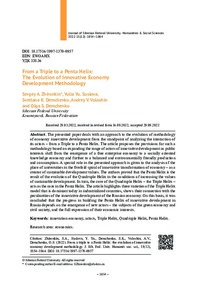From a Triple to a Penta Helix: The Evolution of Innovative Economy Development Methodology
Скачать файл:
URI (для ссылок/цитирований):
https://elib.sfu-kras.ru/handle/2311/149635Автор:
Zhironkin, Sergey A.
Suslova, Yulia Yu.
Demchenko, Svetlana K.
Voloshin, Andrey V.
Demchenko, Olga S.
Жиронкин, С. А.
Суслова, Ю. Ю.
Демченко, С. К.
Волошин, А. В.
Демченко, О. С.
Дата:
2022-12Журнал:
Журнал Сибирского федерального университета. Гуманитарные науки. Journal of Siberian Federal University. Humanities & Social Sciences; 2022 15 (12)Аннотация:
The presented paper deals with an approach to the evolution of methodology of economy innovative development from the standpoint of analyzing the interaction of its actors – from a Triple to a Penta Helix. The article proposes the provisions for such a methodology based on expanding the range of actors of innovative development as public interests shift from the emergence of a free enterprise economy to a socially oriented knowledge economy and further to a balanced and environmentally friendly production and consumption. A special role in the presented approach is given to the analysis of the place of universities in the fivefold spiral of innovative transformation of economy – as a creator of sustainable development values. The authors proved that the Penta Helixis the result of the evolution of the Quadruple Helix in the conditions of increasing the values of sustainable development. In turn, the core of the QuadrupleHelix– the Triple Helix– acts as the core in the Penta Helix. The article highlights three varieties of the TripleHelix model that is dominant today in industrialized countries, shows their connection with the peculiarities of the innovative development of the Russian economy. On this basis, it was concluded that the progress in building the Penta Helix of innovative development in Russia depends on the emergence of new actors – the subjects of the green economy and civil society, and the full expression of their economic interests В представленной статье рассматривается подход к эволюции
методологии развития инновационной экономики с позиций анализа взаимодействия
ее акторов – от тройной к пятеричной спирали. В статье предлагаются положения
методологии, основанной на расширении круга акторов инновационного
развития по мере смещения общественного интереса от становления экономики
свободного предпринимательства к социально ориентированной экономике
знаний и далее – к сбалансированному и экологически безопасному производству
и потреблению. Особая роль в представленном подходе отводится анализу места
университетов в пятеричной инновационной трансформации экономики – как
создателей ценностей устойчивого развития. Авторы доказали, что пятеричная
спираль является результатом эволюции четверной спирали инноваций в условиях
повышения роли ценностей устойчивого развития. В свою очередь, ядро
четверной спирали – тройная спираль – действует и как ядро пятеричной спирали.
В статье выделены три разновидности модели тройной спирали, доминирующей
сегодня в промышленно развитых странах, показана их связь с особенностями
инновационного развития российской экономики. На этом основании сделан вывод,
что прогресс в формировании пятеричной спирали инновационного развития
в России зависит от появления новых акторов – субъектов зеленой экономики
и гражданского общества, полноты выражения их экономических интересов
Коллекции:
Метаданные:
Показать полную информациюСвязанные материалы
Показаны похожие ресурсы по названию, автору или тематике.
-
Формирование модели научно-технологической и инновационной политики в субъекте Российской Федерации
Бывшев, В. И.; Byvshev, Vladimir I. (Journal of Siberian Federal University. Сибирский федеральный университет, 2024-01)Переход передовых экономик к VI технологическому укладу, затянувшаяся череда глобальных политических и экономических кризисов, вызвавших беспрецедентное санкционное давление на Россию и ограничение ее к импорту высоких ... -
“Patent Factory” as a Factor in the Development of Innovative Activity of Society
Vasina, Anastasia V.; Sysoeva, Olga V.; Васина, А. В.; Сысоева, О. В. (Journal of Siberian Federal University. Сибирский федеральный университет, 2024-03)Despite the growing external challenges, the Russian economy has a great potential for its development. Restrictions on economic cooperation (“sanctions”) introduced by a number of countries create many barriers to ... -
Использование информационных коэффициентов пропорциональности для анализа распределения золота в рудном теле Васильевского месторождения
Лабушев, Михаил М.; Borzykh, Olga S.; Labushev, Mikhail M.; Борзых, Ольга С. (Сибирский федеральный университет. Siberian Federal University, 2008-06)На основе использования информационных коэффициентов пропорциональности как математического обобщения понятия «коэффициент пропорциональности» рассматривается пропорциональность содержаний золота в рудном теле Васильевского ... -
Artistic Institution: Causes and Consequences of Silence
Adrià Harillo Pla; Адриà Арильо Пла (Journal of Siberian Federal University. Сибирский федеральный университет, 2025-02)This article presents the potential application of Noelle-Neumann’s Spiral of Silence to the Institutional Theory of Art. Our main hypothesis is that this application is doable. The basic premise is that being art a ... -
“Triple Helix” Model for Recourse-Based Regio
Popodko, Galina I.; Nagaeva, Olga S.; Поподько, Г.И.; Нагаева, О.С. (Сибирский федеральный университет. Siberian Federal University, 2019-12)Exhaustion of non-renewable mineral resources determines sustainable socio-economic development of resource-based regions. However, mineral resource abundance is an essential competitive advantage that can be used for ...

